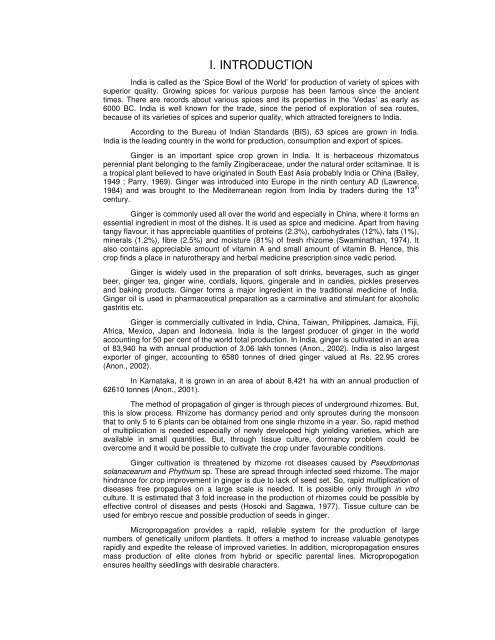MICROPROPAGATION OF GINGER - ETD - University of ...
MICROPROPAGATION OF GINGER - ETD - University of ...
MICROPROPAGATION OF GINGER - ETD - University of ...
Create successful ePaper yourself
Turn your PDF publications into a flip-book with our unique Google optimized e-Paper software.
I. INTRODUCTION<br />
India is called as the ‘Spice Bowl <strong>of</strong> the World’ for production <strong>of</strong> variety <strong>of</strong> spices with<br />
superior quality. Growing spices for various purpose has been famous since the ancient<br />
times. There are records about various spices and its properties in the ‘Vedas’ as early as<br />
6000 BC. India is well known for the trade, since the period <strong>of</strong> exploration <strong>of</strong> sea routes,<br />
because <strong>of</strong> its varieties <strong>of</strong> spices and superior quality, which attracted foreigners to India.<br />
According to the Bureau <strong>of</strong> Indian Standards (BIS), 63 spices are grown in India.<br />
India is the leading country in the world for production, consumption and export <strong>of</strong> spices.<br />
Ginger is an important spice crop grown in India. It is herbaceous rhizomatous<br />
perennial plant belonging to the family Zingiberaceae, under the natural order scitaminae. It is<br />
a tropical plant believed to have originated in South East Asia probably India or China (Bailey,<br />
1949 ; Parry, 1969). Ginger was introduced into Europe in the ninth century AD (Lawrence,<br />
1984) and was brought to the Mediterranean region from India by traders during the 13 th<br />
century.<br />
Ginger is commonly used all over the world and especially in China, where it forms an<br />
essential ingredient in most <strong>of</strong> the dishes. It is used as spice and medicine. Apart from having<br />
tangy flavour, it has appreciable quantities <strong>of</strong> proteins (2.3%), carbohydrates (12%), fats (1%),<br />
minerals (1.2%), fibre (2.5%) and moisture (81%) <strong>of</strong> fresh rhizome (Swaminathan, 1974). It<br />
also contains appreciable amount <strong>of</strong> vitamin A and small amount <strong>of</strong> vitamin B. Hence, this<br />
crop finds a place in naturotherapy and herbal medicine prescription since vedic period.<br />
Ginger is widely used in the preparation <strong>of</strong> s<strong>of</strong>t drinks, beverages, such as ginger<br />
beer, ginger tea, ginger wine, cordials, liquors, gingerale and in candies, pickles preserves<br />
and baking products. Ginger forms a major ingredient in the traditional medicine <strong>of</strong> India.<br />
Ginger oil is used in pharmaceutical preparation as a carminative and stimulant for alcoholic<br />
gastritis etc.<br />
Ginger is commercially cultivated in India, China, Taiwan, Philippines, Jamaica, Fiji,<br />
Africa, Mexico, Japan and Indonesia. India is the largest producer <strong>of</strong> ginger in the world<br />
accounting for 50 per cent <strong>of</strong> the world total production. In India, ginger is cultivated in an area<br />
<strong>of</strong> 83,940 ha with annual production <strong>of</strong> 3.06 lakh tonnes (Anon., 2002). India is also largest<br />
exporter <strong>of</strong> ginger, accounting to 6580 tonnes <strong>of</strong> dried ginger valued at Rs. 22.95 crores<br />
(Anon., 2002).<br />
In Karnataka, it is grown in an area <strong>of</strong> about 8,421 ha with an annual production <strong>of</strong><br />
62610 tonnes (Anon., 2001).<br />
The method <strong>of</strong> propagation <strong>of</strong> ginger is through pieces <strong>of</strong> underground rhizomes. But,<br />
this is slow process. Rhizome has dormancy period and only sproutes during the monsoon<br />
that to only 5 to 6 plants can be obtained from one single rhizome in a year. So, rapid method<br />
<strong>of</strong> multiplication is needed especially <strong>of</strong> newly developed high yielding varieties, which are<br />
available in small quantities. But, through tissue culture, dormancy problem could be<br />
overcome and it would be possible to cultivate the crop under favourable conditions.<br />
Ginger cultivation is threatened by rhizome rot diseases caused by Pseudomonas<br />
solanacearum and Phythium sp. These are spread through infected seed rhizome. The major<br />
hindrance for crop improvement in ginger is due to lack <strong>of</strong> seed set. So, rapid multiplication <strong>of</strong><br />
diseases free propagules on a large scale is needed. It is possible only through in vitro<br />
culture. It is estimated that 3 fold increase in the production <strong>of</strong> rhizomes could be possible by<br />
effective control <strong>of</strong> diseases and pests (Hosoki and Sagawa, 1977). Tissue culture can be<br />
used for embryo rescue and possible production <strong>of</strong> seeds in ginger.<br />
Micropropagation provides a rapid, reliable system for the production <strong>of</strong> large<br />
numbers <strong>of</strong> genetically uniform plantlets. It <strong>of</strong>fers a method to increase valuable genotypes<br />
rapidly and expedite the release <strong>of</strong> improved varieties. In addition, micropropagation ensures<br />
mass production <strong>of</strong> elite clones from hybrid or specific parental lines. Micropropogation<br />
ensures healthy seedlings with desirable characters.

















